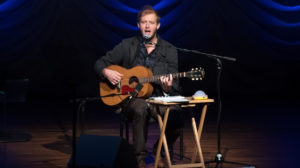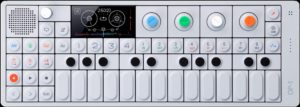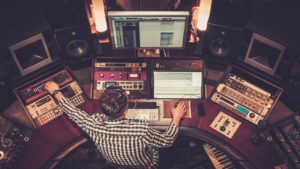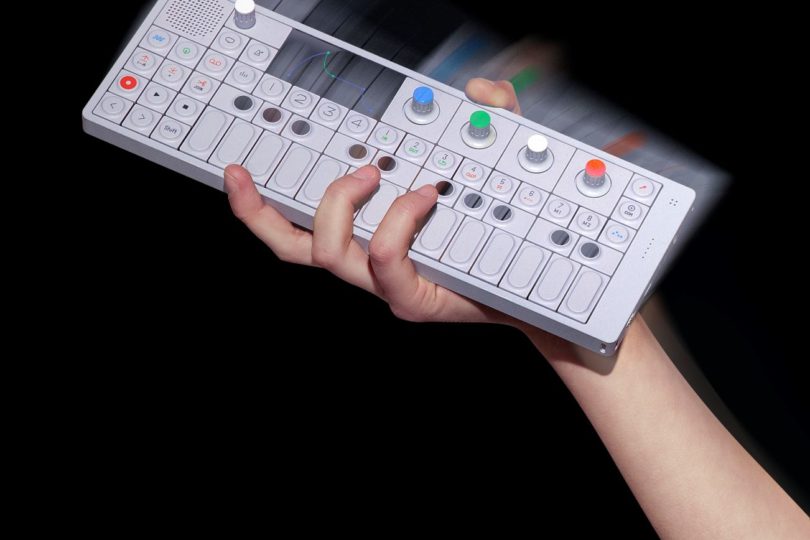The OP-1 is an instrument but, it’s probably unlike any instrument you have ever seen or played. In technical terms the OP-1 is a portable synthesizer, sampler, and controller. It is also one of the most popular instruments you’ve never heard of. Musicians such as Bon Iver, Radiohead’s Thom Yorke, Trent Reznor, and Childish Gambino have all used this instrument and its sound can be heard on countless records.
Created and manufactured by Swedish electronics company, Teenage Engineering, the OP-1 was first released in 2011. Teenage Engineering calls it an all in one wonder synthesizer and to a certain extent they are correct. The OP-1 is about the size of a small keyboard and is easily portable and has more features than a traditional synth + controller at a fraction of the size. It’s features includes: 10 unique synthesizer engines, an instant sampler, 4-track tape, and a full mixer with effects. This rich feature and portable design is changing the way artists make music.
Bon Iver’s, Justin Vernon, would frequently carry this synth with him everywhere while he was recording his latest album 22, a million. He tells a story of singing improvisations into the OP-1 and cutting up the track and hearing a distinct “two..two” and that sample became the eureka moment for Vernon. He says “So that was kind of the beginning of that. And really it was still months until I had any other song ideas, so it was really annoying to have to listen to those 11 seconds of sampled music for that amount of time, but that’s when I figured out that the album was going to be numbers, and 22 is my thing, and it kind of grew from there.”(boniver, 2016)
be.com/watch?v=eNqCVfC4oj4 (Here Vernon talks at length about the creation of his new album and how he got inspiration from the OP-1, go to 6:30 to here Vernon talk about the OP-1)
Vernon uses the OP-1 to capture segments from his favorite songs, the radio, and small melodies. The OP-1 has it’s fingerprints all over Bon Iver’s new album 22, a million, and Vernon credits it as his creative kickstarter. He has said he can no longer sit down with a guitar and get inspiration, he has changed his creative workflow. The OP-1 one has allowed Vernon and many other artists change or enhance their creative process.
 (Here Vernon is seen performing with an OP-1 and acoustic guitar Source: http://grantland.com/hollywood-prospectus/lost-in-the-world-justin-vernon-on-his-new-music-festival-and-the-uncertain-status-of-bon-iver/)
(Here Vernon is seen performing with an OP-1 and acoustic guitar Source: http://grantland.com/hollywood-prospectus/lost-in-the-world-justin-vernon-on-his-new-music-festival-and-the-uncertain-status-of-bon-iver/)
The key feature that has led to the OP-1’s popularity is its size and portability. In the world of synthesizers, the OP-1 is far and away the best in class for its size and has more features than larger synthesizer + controller combos. Portability allows musicians to bring the OP-1 pretty much anywhere. Having this powerful instrument available anywhere gives musicians the ability to create music outside of the traditional studio setting.

Another noteworthy component of the OP-1 is it’s design. It looks much like a child’s toy but the design is intuitive, easy to use, and clean. The OP-1 has won multiple design awards and the San Francisco Museum of Modern Art has an OP-1 included in its permanent collection. It has received praise for its lasting design. French composer, producer, and performer, Jean Michel Jarre said “It’s been a long time since I’ve seen something as interesting, flexible and creative as this. after my tour in sweden, the whole team came back-stage and we jammed together. I chose this synth to show that any instrument, from no matter what time, can have a completely timeless value. I’m sure that musicians will still be using the OP-1 in 50 years.” (Thevenin, 2012)
Computers and technology in general have changed the way music is recorded and sampled to such an extent that people are now longing for analog sound and purchasing physical albums at a historic pace. There are virtually no albums released within the last 20 years that haven’t used a computer or some piece of software during the recording process. This trend of musicians and producers alike turning to digital tools is no accident. Programs like garageband give amateur musicians the power to record and produce their own music in their own home. Some type of music production software is used in the production of virtually every album released today. Artists are now renowned for shirking digital tools and going back to analog recording methods. 
(Source: https://www.adorama.com/alc/seven-tips-to-make-your-recording-studio-computer-run-faster)
Digital tools in music are likely to remain a part of music creation for the foreseeable future. Classic instruments may never be replaced by the likes of the OP-1 but digital instruments are rapidly becoming a new medium for musicians. Digital tools open up a new avenue for creativity in musicians. Digital tools often offer a blank slate for musicians; they can create new sounds, new instruments, and new ways to perform music.
How music is created is often just as important as the actual music itself. Consumers crave authenticity, take for example Bon Iver’s first album For Emma, forever ago. Legend states that Vernon completed the whole album while locked in his father’s cabin in remote Wisconsin one winter. Listeners loved the idea of a musician by themselves in the woods far away from professional studios and the album was a huge success. Compare this with how Vernon’s newest record was made and the differences are overwhelming. Musicians such as Vernon are changing the way they create music by embracing digital tools and in doing so are creating a different kind of music.
Musicians and the music industry are embracing digital tools whether they be: The OP-1, autotune,or software like ableton. This change is affecting the way music is created. Music is now at a point where almost anything is possible. Artists can create novel sounds and pioneer new production techniques with the help of digital tools. Many will contend that digitally produced music, computer music, or music made with digital instruments isn’t ‘real’ music, however I believe that music in the digital age is just a natural progression of the artform. As Kurt Vonnegut once said “No matter how corrupt, greedy, and heartless our government, our corporations, our media, and our religious & charitable institutions may become, the music will still be wonderful.” I believe this holds true no matter how the music is created.
References
boniver. “Bon Iver – 22, A Million Press Conference.” YouTube, YouTube, 27 Oct. 2016, www.youtube.com/watch?v=eNqCVfC4oj4.
Thevenin, Patrick. Red Bull Music Academy Daily, 3 May 2012, daily.redbullmusicacademy.com/2012/05/jarre-synth.
